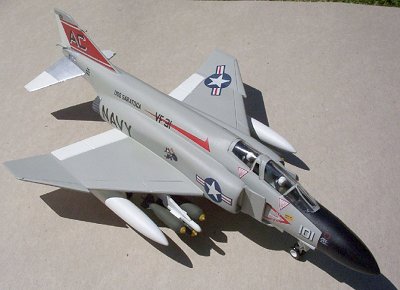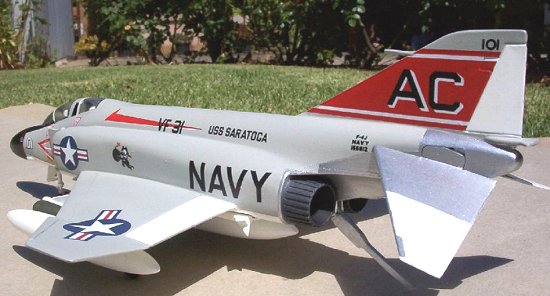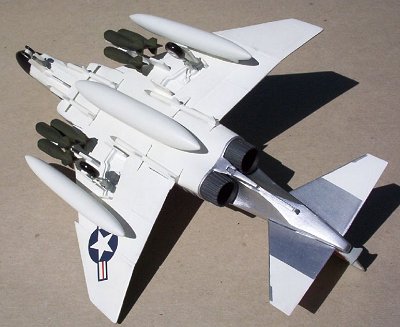
Airfix 1/72 F-4 Phantom II
|
KIT # |
04013 |
|
PRICE: |
Au $19.95 |
|
DECALS: |
US Navy F-4B VF-74, US Air Force F-4C GG, US Air Force F-4D 7466, Israeli Air Force F-4E 610, US Navy F-4J VF-31. |
|
REVIEWER: |
Steven S. Pietrobon |
|
NOTES: |

|
HISTORY |
For a history of the Phantom, please see the other reviews in this
website.
|
THE KIT |

I first built this kit in my youth in the 1970's, however I did a major
stuffup. I swapped the engine inlets 14 and 15, resulting in the
inlets not lining up with the body. As was usual at that time, I did not
use any putty or paint. This time I would get the inlets right! The
kit was moulded in grey, instead of white. The decals were exactly the
same. There are five versions that can be selected, a US Navy F-4B or
F-4J, US Air Force F-4C or F-4D or Israeli Air Force F-4E. I chose
the F-4J as I liked the cat holding the bomb decals on the sides and its
an easier painting scheme with no camouflage. Modern F-4 kits are much
better than the Airfix kit, but as you can see, the Airfix kit can give
quite a good result, despite its 1971 vintage. This was my first
plane kit in 20 years.
|
CONSTRUCTION |
Both the old and new instructions had no painting details for the
interior. I used dark green for the pilot's suit, semi gloss black for
the boots and mask, flesh for the hands and face, and gloss white for the
helmet. The seats and top of the joystick were painted semi gloss
black. Looking at a photo of the cockpit interior, it looked sky blue, so
I painted it duck egg blue. I later learned that the cockpit should be
painted light grey. Using plastic card I added forward and rear
bulkheads.
 The rest of the kit went together well although there was a huge gap
between where the bottom of wings 24 attaches to the front of the
fuselage. Plastic card and a lot of putty and sanding were required to
fill in the gap. I also added a small piece of plastic card under
the rear engines to fix a small inaccuracy. I also added a thin slice of
plastic card between the top of the wings 22 and 23 and the fuselage
halves 7 and 9 to fill in the gap there.
The rest of the kit went together well although there was a huge gap
between where the bottom of wings 24 attaches to the front of the
fuselage. Plastic card and a lot of putty and sanding were required to
fill in the gap. I also added a small piece of plastic card under
the rear engines to fix a small inaccuracy. I also added a thin slice of
plastic card between the top of the wings 22 and 23 and the fuselage
halves 7 and 9 to fill in the gap there.
The left wing trailing edge is a lot thicker than the right wing. Using a
file and a bit of elbow grease helped make the edge thinner. The top
fuselage join also needed some putty. The new plastic felt like hard
candle wax, so after some
sanding, the joint flattened a little.
One trick I thought up after bending the tail aerial a few times, was to
use some masking tape to hold it in place while handling the model.
Painting the interior of the engine inlets was a bit tricky. I first
sprayed dove grey Humbrol 40 behind the inlet. Since that was
gloss, this was then sprayed with a semi gloss varnish. The inlet
interior were painted gloss white and the external part of inlets 12 and
13 dove grey. These were then sprayed with semi gloss varnish. The
back of the inlets was painted matt black.
|
COLORS AND MARKINGS |
After glueing the cockpit glass using Testors Clear Parts Cement, the
cockpit and engine inlets were masked up using Tamiya masking tape in
preparation for spraying primer Humbrol 1. I scribed two hinges behind
each of the two cockpit canopies. This was the only scribing I did
on the model. I left the raised detail untouched. After sanding and
respraying any imperfections, the bottom was sprayed gloss white.
 The bottom and wing and tail aerilons were then masked up in preparation
for spraying the rest of the model dove grey. I used newspaper to cover
most of the bottom which was a mistake. The newspaper left a smudge on
the paint underneath which is hard to remove. I'll be using plain
white paper in future. The tape over the aerial was removed.
The bottom and wing and tail aerilons were then masked up in preparation
for spraying the rest of the model dove grey. I used newspaper to cover
most of the bottom which was a mistake. The newspaper left a smudge on
the paint underneath which is hard to remove. I'll be using plain
white paper in future. The tape over the aerial was removed.
After spraying the dove grey, the masking tape was removed and the nose
was masked up to be painted semi gloss black. The cockpit mask was left
on. It was at this point that I noticed that Humbrol 40 appears a little
too gray. Oh well!
Now was the time to apply the decals. There was some misalignment, but I
was not bothered enough to buy new decals. Apparantly, Airfix will
be producing all their decals inhouse which will hopefully avoid these
alignment problems in
future. I also used decal setting solution (basically diluted acetic acid
or vinegar) for the first time. It worked great! I cut a bit too much
around some decals, like the NAVY and VF-31 decals, which caused some
problem with the decal
folding on itself. The right VF-31 broke into four pieces while trying to
unfold it, but I was able to put it together without any trace that
it was broken. The VF-31 is actually printed VF-91. I cut the 9 to make
it into a 3 and painted Airfix matt red M19 on the rest of the 9 on the
decal. Not a perfect 3, but its pretty close. I also painted some red
sparks coming from the bomb carried by the cat.
The whole model was then painted with semi gloss varnish. The Humbrol
varnish is a little yellow, which shows up on the bottom white
surface. Spraying the varnish also makes it a bit more matt for some
reason. The back was then masked and hand painted silver using my
over 20 year old Humbrol 11. This silver works a lot better than other
new silvers I have bought. Hand painting gives a much better finish than
spraying, which will give a toy like appearance. I made a step in the
line from the engines to the back, which should be straight.
Unfortunately, this is too hard to fix.
|
FINAL ASSEMBLY |
While all the above was going on, I was also preparing the engine
exhausts, Sparrow missiles, undercarriage, fuel tanks, M117 bombs, and
rear tail wings. The fuel tanks and bombs required no putty, but a lot of
sanding was required to get a smooth round finish. A small amount of
putty was used for the rear wings. While the main model was being sprayed
gloss white, this was also used to paint the fuel tanks and rear wing
tips. The landing gear was painted by hand, with the gloss
 white being
covered with semi gloss varnish. One engine exhaust was a bit malformed
which required some sanding to get it back into shape. The exhausts were
painted gun metal with the inside matt black. The tips of the missiles
were painted dove grey. Airfix says to paint the bombs white, but they
should be dark green. A little yellow was painted around the tip and the
tip itself painted silver.
white being
covered with semi gloss varnish. One engine exhaust was a bit malformed
which required some sanding to get it back into shape. The exhausts were
painted gun metal with the inside matt black. The tips of the missiles
were painted dove grey. Airfix says to paint the bombs white, but they
should be dark green. A little yellow was painted around the tip and the
tip itself painted silver.
Attaching the wing fuel tanks was a bit of a pain. The slot into the wing
is loose, so I basically filled the slot with glue, and then let the
pylon set. I also added clear cement around the join, and then painted it
satin white. I put the front gear rear door on the wrong side, but had
also put it in backwards, meaning the circle on the door was close to the
back than the front. This meant that putting it on the correct side, put
the circle also correctly close to the front, which was fortunate. The
last step was painting the side windows on the cockpit gloss black. Not
entirely convincing, but its the best I could do. After a few weeks
sitting on its wheels, the right wheel had a significant tilt on it. As I
tried to straighten the wheel, it came off. I scraped some plastic from
inside the wheel and then superglued it on. Hopefully, the wheel will
stay straight.
|
CONCLUSIONS |
Personally, I felt the kit came out much better than I expected. I think
it looks great. I would recommend the kit for anyone looking for a cheap
Phantom who is also into a bit of model nostalgia. Seeing how I stuffed
the inlets up as a kid, a moderate skill level is required.
|
REFERENCES |
I used various photos I found on the web and "Vietnam Air War Debrief"
edited by R. F. Dorr and C. Bishop, 1996. More photos on the construction
of this kit can be found at
http://www.sworld.com.au/steven/models/phantom/index.html
.
January 2004
If you would like your product reviewed fairly and quickly, please contact me or see other details in the Note to Contributors.